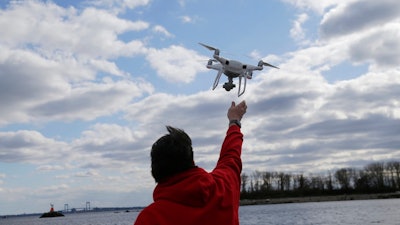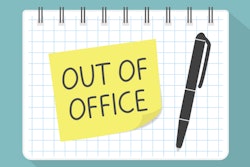
(THE CONVERSATION) The first commercial medical drones are taking flight in the U.S., delivering blood samples and other medical specimens from a clinic to a lab in North Carolina. Right now, they’re just on one hospital campus and not flying over private homes or businesses. But that’s coming soon.
In our research about consumer perceptions of aircraft, we’ve found that in general, people don’t want drones flying over their homes. Helicopters and planes are less of a concern, because they’re usually so high and far away – and people who live near airports are more worried about noise than being spied on.
People see drones, however, as different. They often carry video equipment and are sometimes hard to detect due to their small size. In addition, they can hover for long periods of time, whereas manned aircraft tend to move along quickly. Most people we’ve surveyed express some fear about drones – or their operators – violating their privacy by hovering nearby and potentially videotaping them. That has certainly happened.
We have found that women are generally more concerned than men, particularly when they assume that the drone can take photos or videos. Some people have been so concerned about drones – especially when they lack clear indication of who owns them or are afraid the government is spying on them – that they’ve shot down drones flying over their yards. There are even some companies developing anti-drone weapons designed specifically for these situations.
So far, shooting down a drone has not been punished as harshly as shooting at a manned aircraft. The Federal Aviation Administration has tried to address some public concerns with rules governing personal drones and commercial drone flights. But if drone use is really ever going to take off – both privately and in businesses – the rules need to be a lot clearer for everyone.
What are drones allowed to do?
In most communities, there are not explicit rules on what drone operators are and aren’t allowed to do with their aircraft. The FAA’s general rules ban drones from flying more than 400 feet above the ground, or over people, or above public events. Operators also have to keep their drones in sight at all times.
Drones that are flying for legitimate reasons are usually going to follow a logical path associated with their purpose, like following a pipeline route, surveying property boundaries or examining construction sites. They may hover from time to time, to let operators get a better view of something, but they probably aren’t spying on you – unless they clearly violate reasonable expectations, like following you around a neighborhood or hovering right outside a bedroom window or above a person sunbathing in the yard.
Not every drone flying near your home is feeding video to a peeping Tom. It’s worth remembering that there are, in fact, legitimate reasons drones might be flying around near your home.
Do you hear sirens?
Police agencies around the country use drones to assist with documenting crime scenes, help with event-security planning or assist officers with a standoff. Even though these drones are government-owned and usually equipped with cameras, most likely they’re not trying to invade your privacy.
Police, fire and medical services are very interested in using drones for rapid responses to emergencies. They can fly medicine and equipment into areas where ambulances, and potentially even helicopters, cannot easily go. In Rwanda, drones can deliver a package of fresh blood to anywhere in the western half of the country in less than an hour.
Drones can also help responders plan rescue efforts, identifying areas hit hardest and finding victims in need of aid. People in the affected area can even communicate with drone operators by holding up signs for the cameras.
Is a neighbor’s house for sale?
When listing a home for sale, real estate agents typically arrange for a professional to photograph the home, which helps showcase it to potential buyers. Some agents – for some properties, like larger estates – may want to include aerial photos of the house and land. In the past, this was usually done from a helicopter, at the cost of several hundred dollars.
Now, though, it’s cheaper and faster to fly a small drone above the property. To get the best views, the drone may need to fly off to one side, potentially hovering over a property next door. But if used legitimately for real estate purposes, the cameras are pointed toward the house for sale – not toward the neighbor’s windows.
Is there construction nearby?
Construction companies sometimes use drones to make sure employees are working safely and using tools properly. Drones can also inspect work in high areas that are hard to reach, like roofing details. In some parts of the country, builders are putting up huge suburban developments and keeping an eye on everything with drones. When they fly from one building site to another, they might pass over finished homes that are already occupied, on their way to check out the work at neighboring properties.
Do young kids live in your neighborhood?
Parents may also want to remotely monitor their children at nearby properties like parks. Some parents who may have been reluctant to let their kids explore the neighborhood are finding comfort with drones to help them keep watch. Some schools are also using drones to keep an eye on kids during recess and sports activities.
Are you expecting a package?
Delivery drones aren’t yet common, though they’re being tested in various places around the world. Many companies want to use them to deliver packages, pizza, medications and other items. Within a few years, drones may be buzzing up and down local streets, ferrying all sorts of items to and from homes and businesses. This may be annoying at first, but every drone that goes by means one less car on the road – and less pollution, less traffic congestion and safer streets for cyclists, pedestrians and your children.
One’s overhead right now – what to do?
There are plenty of other perfectly innocent and legal reasons a drone might fly low over your home or yard. Recently, a man was arrested for shooting down a drone that was being used by members of a community group to search for a missing dog.
If you suspect someone is using a drone to spy on you, you should know that under federal law, it is illegal to grab a gun and shoot it down, even if the drone’s operator is violating state laws about where and how they can fly. Some legal experts argue that self-defense should be a legitimate reason, but this is a gray area. So before reaching for ammunition, think about staying out of trouble.
If you’re worried the drone might be invading your privacy, or about to do so, you should be able to spot the operator, because they have to be able to see their drone. If you can get a photo of the drone, the police should be able to track down the operator because most drones must be registered with the FAA and clearly marked with their registration number.
And of course, if you feel under immediate threat, call 911.
This article is republished from The Conversation under a Creative Commons license. Read the original article here: https://theconversation.com/dont-shoot-that-drone-overhead-probably-isnt-invading-your-privacy-114701.






















